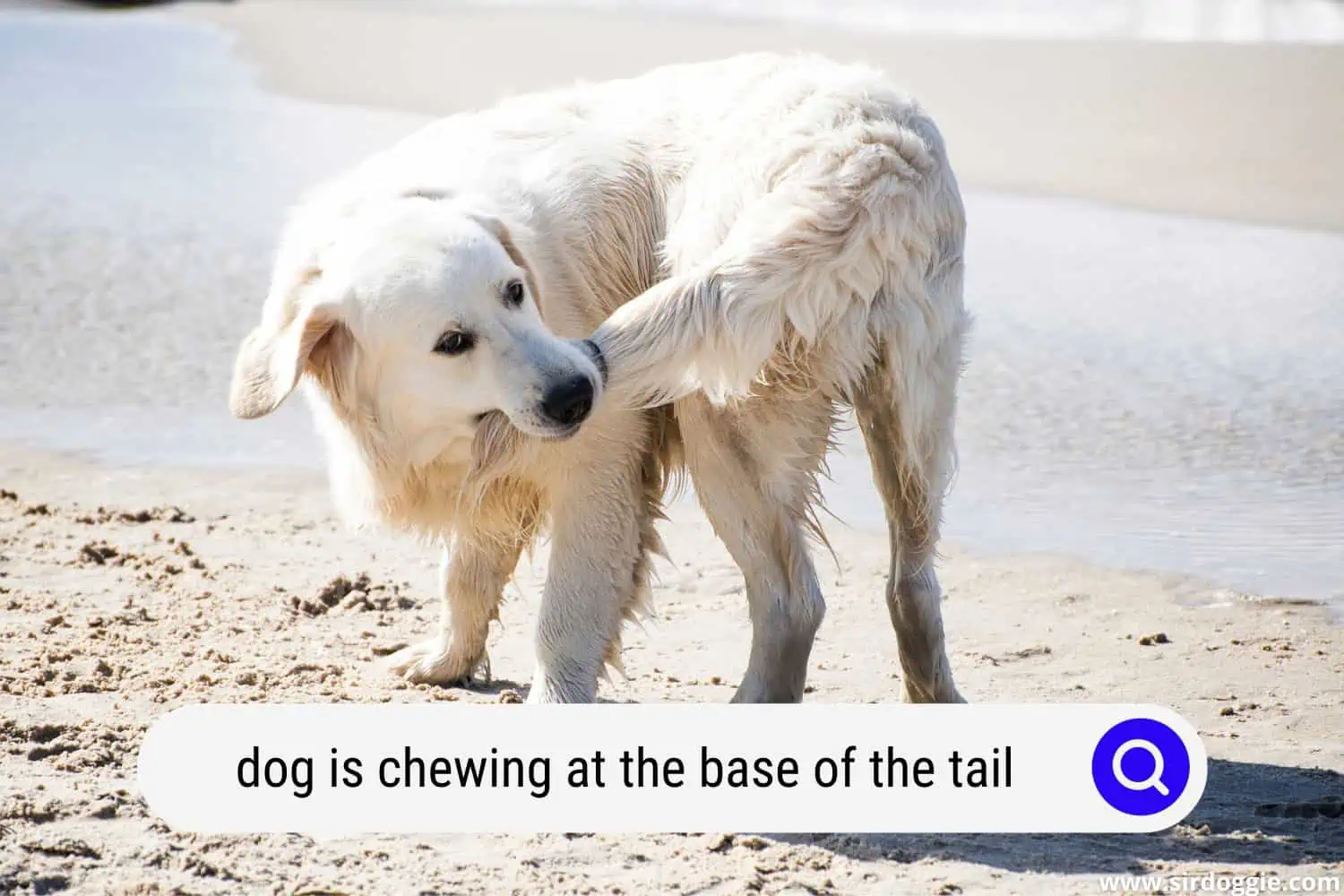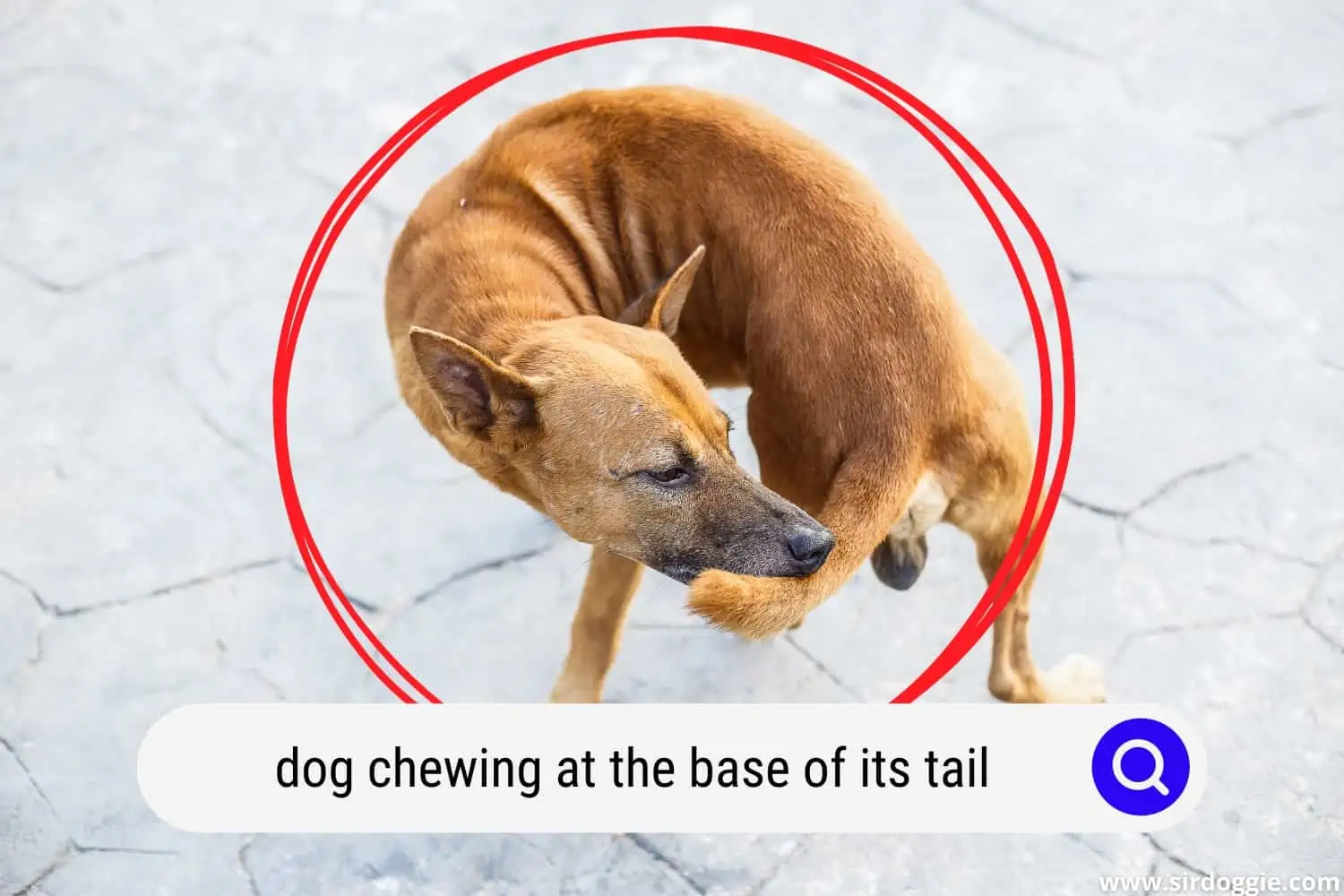Dog Is Chewing At The Base Of The Tail: Is It Just A Weird Habit?
It is no surprise that our canine pals sometimes engage in a very weird behavior that we, humans, cannot explain. Some of their behaviors lead us to believe that something must be wrong with our fluffy friends. When, in fact, it is normal animal characteristics.

Some of the examples can include back-rolling, barking excessively, howling, back-and-forth running, tail-biting, etc. While some of them might be annoying, these are the ways a dog communicates with the other canine companions and with the two-legged creatures as well. However, some are just plain alarming and should not be disregarded. Have you recently noticed that your dog is chewing at the base of the tail? If you answered yes, read on. This could be an indicator that your pooch is suffering from some kind of ailment that you don’t know of. Let’s take a look at the most common dog tail-biting habits and their subsequent reasons.
Dog Is Chewing At The Base Of The Tail: What Are The Main Reasons?
- Skin Infections: like dermatitis, yeast, fungi, and staph infections. With all of these ailments, your dog will experience similar symptoms: redness, swelling, skin rashes, bald spots on the dog’s coat as well as bleeding at the problem area. Canines can’t speak human languages, therefore use signs and gestures to send us a message. If you notice such a troubled pattern of a dog who is biting its tail until it bleeds, it is time to go check it out with your local veterinarian.
- Allergies: occasionally go hand-in-hand with the above-described skin infection cases. If your hound is allergic to something, it will show on its skin right away, and that tail will be “put to work.” You will see a characteristic rash, extreme canine itchiness (to the point of obsession), swelling, and sometimes puss coming out from the open wound being infected by bacterial organisms. It is imperative to find the root of the problem and eliminate it as soon as possible before the issue escalates to extreme levels. A pet parent has to watch his/her fur baby closely to make sure that it’s not allergic to the dry food given out at mealtimes. Or pay attention to how a pup reacts to human food its pet momma/papa shares (like a slice of apple or a piece of bacon). What is completely safe and beneficial to a two-legged, maybe almost poisonous to a dog.
- Parasites: pretty common furry pal’s issue once spring comes. With warmer weather, all sorts of bugs, good and bad, emerge from their winter sleep. Ticks and fleas are more active during the not-so-hot temperatures and prefer to hide in the shade during scorching summer days. Therefore, once you notice that your dog keeps biting the base of the tail, it is crucial to inspect your beloved pooch for parasites. A good idea would be to invest in effective flea and tick protection, like flea collars, chewables, and sprays. Chewy.com has some great products and prices that wouldn’t “bite.”
- Separation Anxiety Disorder: very common amongst pooches who are left home alone for hours on end and start missing their parents terribly. Dogs are social creatures just like their human friends. Therefore they don’t do as well as their feline counterparts if they have to be by themselves for a while. A stressed, sad dog is a recipe for disaster and canines start engaging in pretty destructive behavior like urinating on furniture, howling excessively, or biting their tail until it bleeds. Whenever possible, work from home or come back at a decent hour to spend more time with your lonely mutt. It will be much better behaved and won’t engage in unwanted shenanigans.
- Boredom: sometimes a dog does not necessarily have a separation anxiety disorder, but rather just plain bored. Old toys are not exciting anymore, therefore they find a new one with their tail. Tough chewers can hurt themselves badly by going after their rear end. Hence an owner must nib it in the bud by getting a few puzzle toys like Kong to stimulate their mind and prevent trouble patterns.
- Injury: yes, sometimes a dog’s tail might be hurt and a pet parent wouldn’t even be able to tell. In case you see that your pal keeps biting at the base of the tail and whining, it is a sign that it probably hurt itself while playing rough with those doggie daycare friends. The best solution would be to bring your fur baby to the vet without delay to be examined by a pet specialist. He/she would be able to perform the necessary tests and X-rays to find out what might be the cause of a hound’s discomfort.
- Stuffed Up Anal Glands: pretty “fishy” subject if you ask me. Occasionally you may notice there’s a foul, rotten fish smell coming out of a hound’s booty, and it actively engages in chewing at the base of the tail. Also, you may notice your fluffy fella rubbing its butt up against the floor or carpet. These are signs that its glands might be full and need relief. In this case, you might want to either take your fella to the vet to express its glands or you can try to do it in the comfort of your home. As soon as a pet’s anal problem is eliminated, it will stop biting its tail until it bleeds and be a normal, happy pooch again.
What To Do If Your Dog Is Chewing At The Base Of The Tail?
- Examine Your Pup: a pet parent might be able to easily spot fleas, ticks, mites, and any other parasites that cause a situation where a dog is chewing the hair of its tail. A simple flea/tick shampoo and an anti-parasite spray might help get rid of the trigger. However, if the problem persists, it is best to invest in a tick/flea medication that a veterinary specialist can recommend. In case these steps do not help resolve a problem, it is best to bring a dog to a vet for more definite answers.
- Pay Attention to Its Behavior After a Meal: if a pooch starts actively scratching/biting its paws, body, or tail right after it eats something (whether it’s human or dog food), it is usually an indicator of an allergic reaction. Make sure that you stop giving your canine friend whatever it is that is causing a problem and introduce new foods with caution, one small bite at a time.
- Find More Time to Spend with Your Fur Baby: do you come home every day to a complete mess of a house and a dog with a bleeding part of its body? It might have a separation anxiety disorder and you have to address it immediately before it transforms into open aggression. Try to take some work home if you can, so you can hang out more with your beloved precious pal. Another alternative is to ask a family member/friend/professional dog sitter to lend you a hand and spend some time with this lonely creature. You should notice a difference in your dog’s behavior right away.
- Take It to the Vet: if all else fails, if you are unable to fix the tail-biting problem yourself, take it to the trusted vet of choice to address the issue. A professional might be able to find a solution rather quickly and send a pooch on its way to a happy, biting-free life!

Curl-Up
Whatever a tail-biting reason is, it is creating a stressful, miserable situation for both you and especially for your puppy. It is so important to get to the root of the problem and get rid of the trigger factor. Pay a visit to a local veterinary hospital, unless you can solve the tail-biting puzzle before then by yourself.
Related Reading: A Dog Belly Band: How Does It Work?

Family Dog Expert Author
Hi there! I’m Stuart, a devoted dog lover and family dog expert with over a decade of experience working with our furry companions. My passion for dogs drives me to share my knowledge and expertise, helping families build strong, loving bonds with their four-legged friends. When I’m not writing for SirDoggie, you’ll find me hiking, playing with my beautiful dog, or studying music.